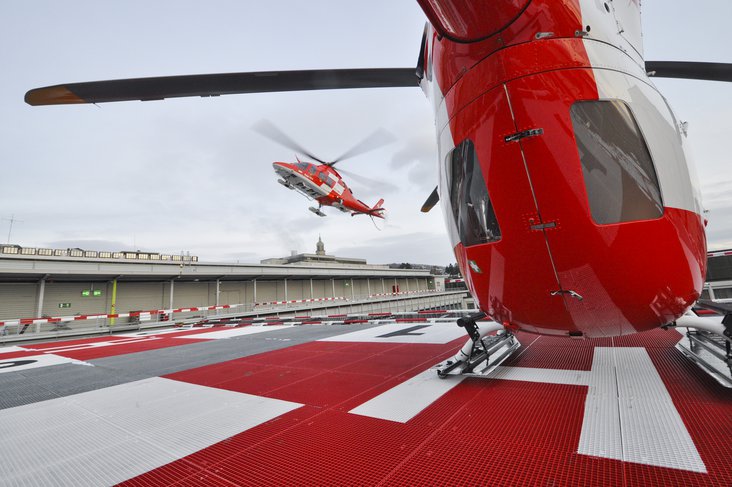In order to further heighten the safety of patients and crews during missions, in collaboration with helicopter manufacturer Leonardo, Rega is testing a laser-based system to automatically detect obstacles to aircraft. The sensor unit continually scans the area in front of the helicopter using a laser and can recognise even thin cables and masts up to two kilometres away. An acoustic signal warns the pilot of obstacles, which are also presented both on a screen in the cockpit and on a head-up display in the pilot’s field of view. The main advantage over passive warning systems, which draw on data from an aviation obstacle database, is that this system also warns of obstacles that are not marked on any maps or charts.
Test flights in the mountains in spring 2017
Rega’s operational area is characterised by a demanding topography and a great many aviation obstacles. Now, joint test flights performed together with the manufacturer set out to show how precisely and reliably the system – which is already being successfully deployed on a number of military helicopters – functions in mountain valleys with an abundance of obstacles, such as cable lifts and wires used by farmers for transporting hay. The test flights are to take place in northern Italy this spring in collaboration with the helicopter manufacturer, Leonardo, with a view to adopting the system in the three new AW169-FIPS all-weather rescue helicopters from 2021. Rega CEO Ernst Kohler says: “At Rega, the safety of our patients and crews is of top priority. We are constantly striving towards making improvements and further increasing safety. And we go to great lengths to achieve this, whether in the form of staff training courses, in our organisational set-up or, as in this case, in the deployment of cutting-edge technology.”
Video laryngoscope: a camera to provide a clearer view
In the field of medicine, too, Rega is employing state-of-the-art technology to improve the medical care it provides to its patients. For example, crews are now equipped with a video laryngoscope for securing a patient’s airway. On the tip of the spatula, next to the light source, is a tiny camera, which transmits signals to a small monitor. This device for image-guided intubation has been in use in Swiss hospitals for a number of years. Now Rega has at its disposal a technically more advanced, robust, mobile video laryngoscope that can also be used outside the hospital in adverse weather conditions. As a result, not only the physician performing the intubation, but also the paramedic or intensive care flight nurse assisting, have a clear view of the procedure via the images on the monitor. The crew from the Rega helicopter base in Berne successfully tested the device over the course of a year on rescue missions. They even took it out in bright sunlight and snow to check whether the image on the display is still easy to see. The new video laryngoscope will soon be standard equipment on board the Rega fleet.
Once again more than 15,000 missions in a single year
In 2016, Rega’s Operations Centre organised a total of 15,093 missions, slightly more than in the previous year (+0.3 %). Figures for the helicopter missions were marginally down compared to the year before (11,055, –1.2 %). Generally speaking, the helicopter mission statistics reflect the meteorological conditions and leisure activities of people in Switzerland. Due to the mild and consequently relatively snow-free winter, the Rega helicopters flew considerably fewer missions in the months of January (–4.7 %) and February (–17.6 %) than in 2015. In contrast, the exceptionally sunny September (+18.2 %) led to extremely busy operation days.
Meanwhile, the operations performed by Rega’s three ambulance jets registered a growth: in the course of 858 missions (+4.6 %), a total of 869 patients (+5.3 %) were flown back home to Switzerland from all corners of the globe. The number of patients repatriated on board scheduled aircraft also rose significantly (354, +12 %). This alternative to the ambulance jet is employed provided that the patient’s medical condition is sufficiently stable and that this form of transport is not expected to have a negative impact on the patient or other passengers.
Gratifying development in patronage numbers
Patrons form the very backbone of Rega. With their annual contributions, in 2016 they covered more than 60 percent of the overall costs, thus enabling Switzerland to benefit from an air-rescue system that sets standards and is highly regarded throughout the world. On 31 December 2016, a total of 3.376 million individuals were registered as Rega patrons, representing an increase of around 93,000 persons in comparison with the previous year. Rega CEO Ernst Kohler is grateful for the continuing enormous support within the Swiss population: “Thanks to the solidarity on the part of our patrons, we are able to operate independently of state funding or commercial interests and to place the welfare of our patients at the centre of everything we do.”

